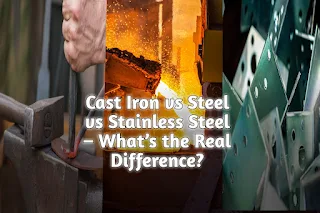Cast Iron, Steel, or Stainless Steel – What’s the Difference and Why It Matters?
In our daily lives, we use many metal items like kitchen utensils, building rods, gates, and machine parts. But most people don’t clearly know the difference between cast iron, steel, and stainless steel. This simple guide explains each metal, their uses, and helps you choose the right one—especially if you're buying a skillet.
Cast Iron
Cast iron is made from iron mixed with 2.1% to 4% carbon. It’s very hard but also brittle, meaning it can break if dropped.
Features:
Very hard but can crack
Absorbs vibration well
Ideal for making complex shapes
Can rust if not oiled properly
Common Uses:
Engine blocks, cookware like skillets and tavas, manhole covers, and machinery parts
Types:
Gray cast iron, white cast iron, ductile iron
Steel
Steel is a mix of iron and less carbon (0.02% to 2.1%). It is strong, flexible, and can be customized by adding elements like chromium or manganese.
Types:
Mild Steel (0.05%–0.25%): Soft, easy to weld
Medium Carbon Steel (0.25%–0.6%): Strong, used in vehicles
High Carbon Steel (0.6%–1.5%): Very hard, used in tools
Common Uses:
TMT rods, machinery parts, tools, and pipes
Stainless Steel
Stainless steel contains iron, carbon, and at least 10.5% chromium, which gives it a shiny finish and rust resistance. It may also include elements like nickel or molybdenum.
Features:
Rust-resistant and shiny
Easy to clean and hygienic
Heat-resistant and durable
Common Uses:
Cookware, cutlery, kitchen sinks, medical tools, and railings
Quick Comparison Table
Property Cast Iron Steel Stainless Steel
Carbon Content 2.1%–4% 0.02%–2.1% 0.02%–2.1% + Chromium
Strength Very High High High and Rust-Free
Flexibility Low Medium High
Rust Resistance Low Medium Very High
Price Low Medium High
Common Uses Cookware Construction Kitchen, Medical
Spark Test – How to Identify Metals
Cast Iron: Short, dull orange sparks
Steel: Long yellow sparks with branches
Stainless Steel: Few white straight sparks
Which Skillet Is Best for Your Kitchen?
Choosing the right skillet depends on your cooking needs, experience, and how much care you want to give. Here’s a detailed breakdown:
Cast Iron Skillet
Advantages:
Excellent heat retention, great for frying and searing, affordable (₹1500–₹2000)
Disadvantages:
Rusts if not oiled properly, heavy to lift, reacts with acidic food
Maintenance Tip:
Wash, dry, heat, and apply oil after each use
Best For:
Beginners and budget-friendly cooking
Carbon Steel Skillet
Advantages:
Lighter than cast iron, heats quickly, becomes nonstick when seasoned, durable (₹4000–₹6000)
Disadvantages:
Needs regular oiling, not ideal for acidic food in early use
Best For:
Fast cooking and experienced home cooks
Stainless Steel Skillet
Advantages:
Rust-proof, low maintenance, heats and cools quickly, good for sauces (₹8000–₹10,000)
Disadvantages:
Not nonstick unless used with proper technique
Best For:
Cooking sauces, pasta, and quick clean-up kitchens
Skillet Comparison Table
Skillet Type Weight Nonstick Maintenance Sauce Making Price
Cast Iron Heavy Good High Not Ideal Budget
Carbon Steel Medium Excellent Medium Not Ideal Mid-range
Stainless Steel Light Depends Low Excellent Expensive
Final Suggestion
If you’re new to cooking, go for cast iron — it’s affordable and reliable.
If you have some experience and want more control, carbon steel is a great upgrade.
If you prefer low-maintenance cookware and make a lot of sauces, stainless steel is best for you.

